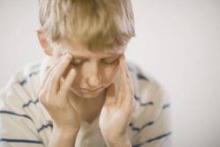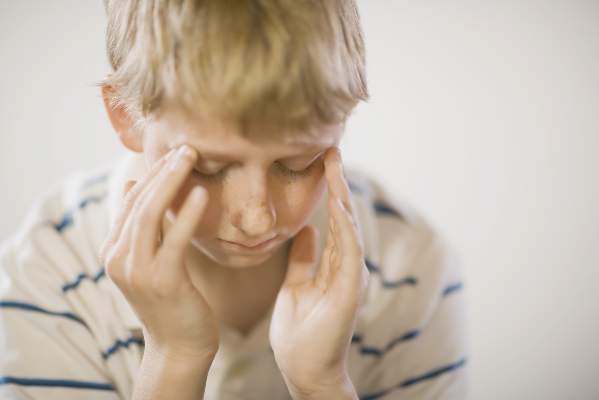User login
WASHINGTON – Treatment of acute migraine in pediatric patients needs substantial improvement, particularly from providers in metropolitan areas, according to a retrospective observational study presented at the annual meeting of the American Headache Society.
“We know that there are practice parameters outlined by the [American Academy of Neurology] and other organizations, that there are expert recommendations, and [Food and Drug Administration]-approved medications,” said Robert A. Nicholson, Ph.D., director of behavioral medicine at Mercy Clinic Headache Center, St. Louis. “So there is definitely useful and effective treatment information available for dealing with pediatric migraine patients.”
Dr. Nicholson and his coinvestigators collected electronic health records data on 94,444 cases in children aged 6-17 years, including 32,926 children in the study. All subjects presented with primary migraine and headache to 1 of 1,617 metropolitan and nonmetropolitan primary care, specialty care, or emergency departments between January 2009 and June 2014. Children were included based on a multi-input inclusion algorithm, which “determined presence of primary migraine, headache, or undiagnosed primary migraine,” and were excluded for post-traumatic presentation, neoplasms, pregnancy, and “infectious conditions for which headache was secondary.”
Just 16.1% of children received evidence-based medications for their acute migraine, while 37.9% received other medication and 46% did not receive any medication at all. Furthermore, 45.7% of subjects did not receive any diagnosis when they presented; only 17.7% were diagnosed with a migraine, while 36.6% received a headache diagnosis. Evidence-based medications most commonly prescribed were NSAIDs, triptans, and acetaminophen.
The percentage of children who received medication improved as they got older, with those aged 15-17 years receiving diagnoses and medications more consistently. Children who received the correct diagnosis at a younger age were better off in terms of getting medication more consistently as they aged.
“We see here that migraine does go up over time, but even in the best-case scenario, only about one out of four kids who are 15-17 [years] get evidence-based medication,” said Dr. Nicholson. “So although we find that there is a decrease in migraines as kids get older, it’s not as if we suddenly find some magical point at which they receive optimal treatment, it’s just that treatment gets less woeful than it was when kids are younger.”
Nearly 57% of subjects were female, and over 78% were white. Providers were predominantly located in metropolitan areas (78.2% vs. 21.8% nonmetropolitan) and 64.6% of centers were primary centers, 26.5% were emergency or urgent care departments, and 9% were specialty.
“We also found that providers in metropolitan areas were less likely to prescribe evidence-based medicine,” he said. “We don’t yet know much about that, [but] we’re going to do more work on that, as it’s something we found that we thought would be the exact opposite.”
Dr. Nicholson acknowledged the Migraine Research Foundation and the Mercy Research/MTS for their support of this study. He did not report any other relevant disclosures.
WASHINGTON – Treatment of acute migraine in pediatric patients needs substantial improvement, particularly from providers in metropolitan areas, according to a retrospective observational study presented at the annual meeting of the American Headache Society.
“We know that there are practice parameters outlined by the [American Academy of Neurology] and other organizations, that there are expert recommendations, and [Food and Drug Administration]-approved medications,” said Robert A. Nicholson, Ph.D., director of behavioral medicine at Mercy Clinic Headache Center, St. Louis. “So there is definitely useful and effective treatment information available for dealing with pediatric migraine patients.”
Dr. Nicholson and his coinvestigators collected electronic health records data on 94,444 cases in children aged 6-17 years, including 32,926 children in the study. All subjects presented with primary migraine and headache to 1 of 1,617 metropolitan and nonmetropolitan primary care, specialty care, or emergency departments between January 2009 and June 2014. Children were included based on a multi-input inclusion algorithm, which “determined presence of primary migraine, headache, or undiagnosed primary migraine,” and were excluded for post-traumatic presentation, neoplasms, pregnancy, and “infectious conditions for which headache was secondary.”
Just 16.1% of children received evidence-based medications for their acute migraine, while 37.9% received other medication and 46% did not receive any medication at all. Furthermore, 45.7% of subjects did not receive any diagnosis when they presented; only 17.7% were diagnosed with a migraine, while 36.6% received a headache diagnosis. Evidence-based medications most commonly prescribed were NSAIDs, triptans, and acetaminophen.
The percentage of children who received medication improved as they got older, with those aged 15-17 years receiving diagnoses and medications more consistently. Children who received the correct diagnosis at a younger age were better off in terms of getting medication more consistently as they aged.
“We see here that migraine does go up over time, but even in the best-case scenario, only about one out of four kids who are 15-17 [years] get evidence-based medication,” said Dr. Nicholson. “So although we find that there is a decrease in migraines as kids get older, it’s not as if we suddenly find some magical point at which they receive optimal treatment, it’s just that treatment gets less woeful than it was when kids are younger.”
Nearly 57% of subjects were female, and over 78% were white. Providers were predominantly located in metropolitan areas (78.2% vs. 21.8% nonmetropolitan) and 64.6% of centers were primary centers, 26.5% were emergency or urgent care departments, and 9% were specialty.
“We also found that providers in metropolitan areas were less likely to prescribe evidence-based medicine,” he said. “We don’t yet know much about that, [but] we’re going to do more work on that, as it’s something we found that we thought would be the exact opposite.”
Dr. Nicholson acknowledged the Migraine Research Foundation and the Mercy Research/MTS for their support of this study. He did not report any other relevant disclosures.
WASHINGTON – Treatment of acute migraine in pediatric patients needs substantial improvement, particularly from providers in metropolitan areas, according to a retrospective observational study presented at the annual meeting of the American Headache Society.
“We know that there are practice parameters outlined by the [American Academy of Neurology] and other organizations, that there are expert recommendations, and [Food and Drug Administration]-approved medications,” said Robert A. Nicholson, Ph.D., director of behavioral medicine at Mercy Clinic Headache Center, St. Louis. “So there is definitely useful and effective treatment information available for dealing with pediatric migraine patients.”
Dr. Nicholson and his coinvestigators collected electronic health records data on 94,444 cases in children aged 6-17 years, including 32,926 children in the study. All subjects presented with primary migraine and headache to 1 of 1,617 metropolitan and nonmetropolitan primary care, specialty care, or emergency departments between January 2009 and June 2014. Children were included based on a multi-input inclusion algorithm, which “determined presence of primary migraine, headache, or undiagnosed primary migraine,” and were excluded for post-traumatic presentation, neoplasms, pregnancy, and “infectious conditions for which headache was secondary.”
Just 16.1% of children received evidence-based medications for their acute migraine, while 37.9% received other medication and 46% did not receive any medication at all. Furthermore, 45.7% of subjects did not receive any diagnosis when they presented; only 17.7% were diagnosed with a migraine, while 36.6% received a headache diagnosis. Evidence-based medications most commonly prescribed were NSAIDs, triptans, and acetaminophen.
The percentage of children who received medication improved as they got older, with those aged 15-17 years receiving diagnoses and medications more consistently. Children who received the correct diagnosis at a younger age were better off in terms of getting medication more consistently as they aged.
“We see here that migraine does go up over time, but even in the best-case scenario, only about one out of four kids who are 15-17 [years] get evidence-based medication,” said Dr. Nicholson. “So although we find that there is a decrease in migraines as kids get older, it’s not as if we suddenly find some magical point at which they receive optimal treatment, it’s just that treatment gets less woeful than it was when kids are younger.”
Nearly 57% of subjects were female, and over 78% were white. Providers were predominantly located in metropolitan areas (78.2% vs. 21.8% nonmetropolitan) and 64.6% of centers were primary centers, 26.5% were emergency or urgent care departments, and 9% were specialty.
“We also found that providers in metropolitan areas were less likely to prescribe evidence-based medicine,” he said. “We don’t yet know much about that, [but] we’re going to do more work on that, as it’s something we found that we thought would be the exact opposite.”
Dr. Nicholson acknowledged the Migraine Research Foundation and the Mercy Research/MTS for their support of this study. He did not report any other relevant disclosures.
AT THE AHS ANNUAL MEETING
Key clinical point: Many children with acute migraine are not prescribed medication of any kind or are receiving suboptimal medical care.
Major finding: Only 16% of children in this study received an evidence-based medication, and nearly 50% of children with acute migraine received no medication at all.
Data source: Retrospective, observational study of 32,926 children, aged 6-17 years, reporting to one of 1,617 providers across four states for migraine between January 2009 and June 2014.
Disclosures: Dr. Nicholson acknowledged the Migraine Research Foundation and the Mercy Research/MTS for their support of this study. No other relevant disclosures were reported.

